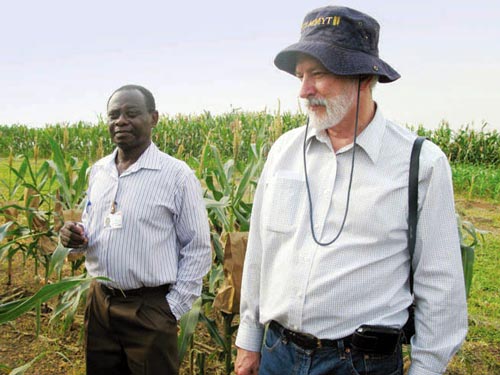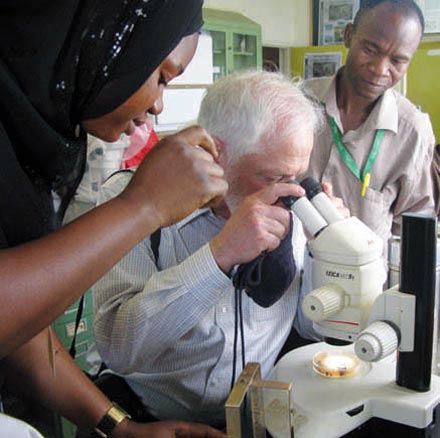 On 15 February 2012, CIMMYT director general Tom Lumpkin met with his peer, Nteranya Sanginga, at the headquarters of the International Institute of Tropical Agriculture (IITA) in Ibadan, Nigeria. Accompanied by CIMMYT-Regional Liaison Officer, Wilfred Mwangi, Lumpkin also interacted with IITA maize breeders Baffour Badu-Apraku, Abebe Menkir, and Sam Ajala, as well as IITA socioeconomist Tahirou Abdoulaye.
On 15 February 2012, CIMMYT director general Tom Lumpkin met with his peer, Nteranya Sanginga, at the headquarters of the International Institute of Tropical Agriculture (IITA) in Ibadan, Nigeria. Accompanied by CIMMYT-Regional Liaison Officer, Wilfred Mwangi, Lumpkin also interacted with IITA maize breeders Baffour Badu-Apraku, Abebe Menkir, and Sam Ajala, as well as IITA socioeconomist Tahirou Abdoulaye.
Topics of discussion included governance and management of MAIZE, the CGIAR research program launched in July 2011 and jointly led by CIMMYT and IITA. The initiative aims to meet the annual food demand of an additional 135 million consumers by 2020 and an additional 600 million by 2030.
 Lumpkin and Mwangi visited IITA maize trials, including those of maize bred for resistance to the parasitic flowering plant, Striga spp., through crosses with teosinte. Attaching to sprouting maize seedlings, Striga saps nutrients and imparts a toxin that slows growth. It causes damage to Africa’s maize estimated in the billions of dollars and affects as much as 40 million hectares of food crops across the region. Teosinte belongs to the same genus as maize and is considered the crop’s predecessor.
Lumpkin and Mwangi visited IITA maize trials, including those of maize bred for resistance to the parasitic flowering plant, Striga spp., through crosses with teosinte. Attaching to sprouting maize seedlings, Striga saps nutrients and imparts a toxin that slows growth. It causes damage to Africa’s maize estimated in the billions of dollars and affects as much as 40 million hectares of food crops across the region. Teosinte belongs to the same genus as maize and is considered the crop’s predecessor.
Maize was the main focus of the visit, but wheat in West Africa emerged as an important subject. Nigeria currently imports USD 4 billion of wheat. Now at over 150 million, the country’s population is expected to exceed 400 million by 2050. Regarding increasing populations and their implications for food security, Dr. Sanginga stated: “In the end, we don’t care about IITA, CIMMYT, or what have you. What we do care about is that we solve the problem….CIMMYT is an important ally of IITA. This visit reassures us of CIMMYT’s commitment to delivering improved maize technologies for food security in Africa.”
The call at IITA was one of three recent visits by Lumpkin to CGIAR centers in Africa, including the World Agroforestry Center and ILRI.